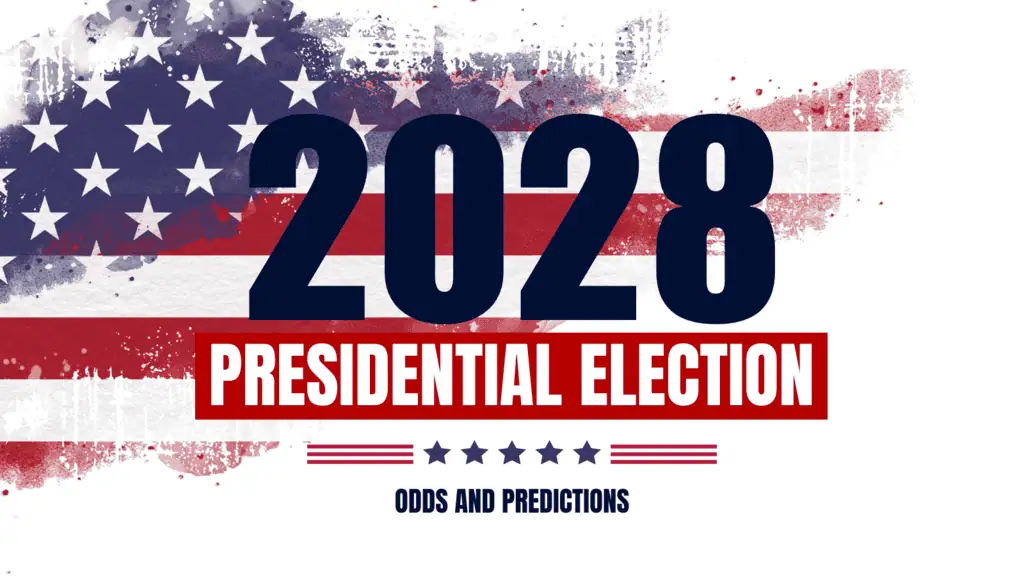Table of Contents
The 2024 U.S. presidential election may have just ended, but the 2028 election is already creating plenty of buzz. With no incumbent in the race, both parties are gearing up for what could be a defining election. Donald Trump is about to serve his second term, of course, and the US Constitution forbids anyone from seeking a third.
From frontrunners to underdogs, the 2028 political landscape is shaping up to be one of the most competitive in recent memory. Let’s break down the early 2028 election odds, top candidates, and make a few predictions for the next federal election.
When Is the Next Presidential Election?
The next U.S. presidential election is scheduled for Tuesday, November 7, 2028. The road to the White House officially kicks off much earlier, with primaries beginning in early 2028. Expect debates, Super Tuesday, and party conventions to dominate the headlines well before the general election.
Presidential Election Odds
Check out the latest 2028 Presidential Election odds and prop bets:
| Presidential Election Prop Bet | Favorite | Prediction |
|---|---|---|
| 2028 Republican Candidate | JD Vance | JD Vance |
| 2028 Democratic Candidate | Gavin Newsom | Gavin Newsom |
| 2028 Presidential Winning Party | Republican Party | Republican Party |
| 2028 Presidential Winner | JD Vance | Gavin Newsom |
Political betting markets are buzzing with activity and now is the time to jump on futures bets if you’re confident in a dark horse or early favorite. Keep in mind that the odds will shift as we get closer to the primaries and general election, so timing your bet can be crucial.
2028 US Presidential Election Predictions
The following is a breakdown of the latest US Presidential Election prop bets, courtesy of the top politics betting sites:
2028 US Presidential Election Republican Nominee
The race for the Republican nomination features several high-profile candidates. Here are the current odds for the GOP’s top contenders:
- JD Vance (+125)
- Marco Rubio (+800)
- Ron DeSantis (+800)
- Nikki Haley (+1400)
- Vivek Ramaswamy (+1400)
- Tom Cotton (+2200)
- Brian Kemp (+2500)
JD Vance
JD Vance, the author-turned-senator-turned-vice president, has quickly climbed the ranks in Republican politics, earning a reputation as a champion of populist ideals. Known for his best-selling memoir Hillbilly Elegy and his deep ties to working-class America, Vance has leveraged his personal story to connect with voters who feel left behind by globalization and cultural shifts. His rhetoric on economic nationalism, reducing the influence of tech monopolies, and reshaping foreign policy has earned him widespread support among the GOP’s base.
Vance has risen the political ranks incredibly quickly. He was elected to represent Ohio in the US Senate in 2020, and 4 years later he was tapped to serve as Trump’s vice president. Naturally, with Trump unable to run for a third term, VP-elect Vance looks like the most likely candidate to take the torch and run with it. If a sitting president endorses his VP for the presidency in the next election, the rest of the party almost always falls in line.
If Trump does endorse Vance, I wouldn’t expect a whole lot of resistance from within the Republican Party. Trump’s loyalty is famously tough to keep, so there’s no guarantee Vance will remain in Trump’s good graces throughout the term. Remember, there’s a reason Mike Pence wasn’t Trump’s VP this time around.
However, while Vance excels in appealing to the populist wing of the party, he faces significant challenges. Critics question his ability to broaden his appeal to moderates and independents, crucial demographics in the general election. Additionally, his relatively short political career may lead to skepticism about his readiness for the presidency. Vance’s success will likely depend on whether he can strike a balance between energizing the GOP’s base and addressing concerns about his experience and divisive rhetoric.
Ron DeSantis
Ron DeSantis has cemented his position as a powerhouse in Republican politics. The Florida governor has gained national attention for his handling of state-level issues, particularly his pandemic policies, which appealed to conservative voters. DeSantis has made education reform, economic growth, and resistance to federal overreach key pillars of his platform, resonating with traditional conservatives and moderates alike.
If Vance doesn’t get the nomination, DeSantis will likely be viewed as one of the frontrunners on the GOP side. DeSantis infamously launched a campaign in 2024, though he was among the many candidates who was soundly beaten by Trump in the primary. He attempted to distance himself from Trump while he was a candidate, only to fall back in line and endorse Trump once he suspended his campaign.
One of DeSantis’s key strengths lies in his ability to project competence and authority. Unlike some candidates who rely heavily on fiery rhetoric, DeSantis combines strong messaging with a record of governance that has boosted Florida’s economic and population growth. However, he faces stiff competition from more populist figures like Vance and Ramaswamy, who could divide the party’s base. To secure the nomination, DeSantis must maintain his coalition of supporters while fending off challenges from both the establishment and populist wings of the GOP.
Nikki Haley
Nikki Haley, a former U.N. ambassador and South Carolina governor, offers a unique blend of experience and relatability. She has framed herself as a unifier within the party, someone who can appeal to traditional conservatives, moderates, and younger voters. Haley’s tenure at the United Nations showcased her foreign policy acumen, a key selling point for voters who prioritize America’s global standing.
Haley was another candidate who ran in 2024 and fell by the wayside as Trump dominated the GOP primary. Haley was reluctant to endorse Trump, unlike several other candidates, which may have an effect on her future viability. Haley will almost surely make another run at the White House at some point, but she’s going to struggle to generate enthusiasm if she’s still viewed by Republican voters as anti-Trump.
While Haley’s odds of securing the nomination are longer compared to Vance and DeSantis, she has the potential to gain traction if she can carve out a niche among suburban women and independents. Her moderate tone and emphasis on pragmatic governance could make her a formidable contender in the general election, even if her path to the nomination remains challenging. Haley’s candidacy will depend on her ability to break through the noise in a crowded Republican field and differentiate herself from more polarizing figures.
Bet: JD Vance (+125)
2028 US Presidential Election Democratic Nominee
On the Democratic side, the race is shaping up to be just as competitive, with these candidates leading the pack:
- Gavin Newsom (+300)
- Josh Shapiro (+400)
- Gretchen Whitmer (+600)
- Pete Buttigieg (+1000)
- Andy Beshear (+1200)
- Raphael Warnock (+1800)
- Michelle Obama (+1200)
Gavin Newsom
Gavin Newsom is widely regarded as the frontrunner for the Democratic nomination, and for good reason. As governor of California, Newsom has built a national profile by championing progressive policies on climate change, healthcare, and housing. His polished image and charismatic communication style make him a natural fit for a party eager to energize its base and appeal to younger voters.
However, Newsom faces several hurdles. Critics argue that his tenure as governor has been marred by policy failures on homelessness and the cost of living in California, issues that opponents are likely to exploit. Additionally, his progressive stance may alienate swing voters in key battleground states. To secure the nomination, Newsom must balance his progressive credentials with a message that resonates across the broader electorate.
Republicans constantly paint California as some sort of hellscape, and you can bet they’ll attempt to use all the ammo they can find in an attempt to paint Newsom as a radical if he earns the nomination. The governor has done a fine job of defending himself on the national stage, however, and he infamously debated DeSantis in 2024 despite not even being in a race for national office.
Gretchen Whitmer
Michigan Governor Gretchen Whitmer has emerged as a compelling contender for the Democratic nomination, particularly for her ability to win in a crucial battleground state. Whitmer’s leadership during the COVID-19 pandemic and her focus on infrastructure investment have earned her widespread praise. Her emphasis on job creation and bipartisan collaboration makes her a strong candidate for Democrats looking to appeal to moderates and independents.
Whitmer’s appeal lies in her relatability and track record of delivering results in a politically divided state. However, her more measured approach may struggle to energize the party’s progressive base, a key demographic in the primaries. To gain momentum, Whitmer will need to articulate a clear vision that unites the party while addressing pressing national issues such as healthcare and climate change.
Is the United States ready to vote for a female president? That’ll be one of the questions dominating the 2028 race. The Democrats infamously nominated Hillary Clinton (2016) and Kamala Harris (2024), and both were defeated by Trump in the general election. Whitmer has been viewed as a rising star within the Democratic Party for the last few years, though, and her status as a popular governor in a swing state likely wouldn’t hurt her chances.
Michelle Obama
Michelle Obama remains the ultimate wildcard in the Democratic field. Despite repeatedly downplaying the possibility of running, her unmatched name recognition and popularity make her a fascinating hypothetical candidate. As a former First Lady, Obama has a unique ability to connect with voters on a deeply personal level, offering a message of hope, resilience, and unity.
If Obama were to enter the race, she would instantly dominate the conversation, drawing massive support from across the Democratic spectrum. However, her lack of political experience and apparent reluctance to enter the political arena are significant barriers. While her candidacy remains speculative, the sheer excitement around the possibility highlights her enduring influence on American politics.
Bet: Gavin Newsom (+300)
2028 US Presidential Election Winning Party
- Republican Party (-170)
- Democratic Party (+130)
- Independent Candidate (+8000)
The Republican Party currently has the edge according to oddsmakers, likely buoyed by a favorable electoral map and momentum in key states. However, Democrats have consistently shown their ability to mobilize voters in critical swing areas, making this prop bet a closely watched one.
The last 2 presidents have been one-term wonders, which means incumbency may no longer be the advantage it once was. Trump was ousted in 2020 following his term, while the Democrats lost to Trump after just one term for the Biden Administration. The second Trump administration is facing plenty of headwinds, and we saw how quickly his approval rating tumbled after his shocking 2016 victory. If Trump can’t deliver on campaign promises or chaos thwarts his term once again, voters may be eager to swing back toward the Democratic Party by the time ’28 rolls around.
The best bet here is the Democrats to reclaim the White House at +130.
Bet: Democratic Party (+130)
2028 US Presidential Election Odds for Top Candidates
| Candidate | Odds | Candidate | Odds |
|---|---|---|---|
| JD Vance | +250 | Josh Shapiro | +700 |
| Gavin Newsom | +700 | Gretchen Whitmer | +1200 |
| Raphael Warnock | +1800 | Nikki Haley | +1400 |
| Andy Beshear | +2000 | Vivek Ramaswamy | +2200 |
| Pete Buttigieg | +1600 | Mark Cuban | +2800 |
While Vance and Newsom are leading the odds, DeSantis and Whitmer may emerge as strong contenders. As the race evolves, watch for shifts in these odds as debates, fundraising, and polling begin to shape the narrative.
The 2028 presidential election is shaping up to be one of the most fascinating contests in recent history. Whether you’re placing a futures bet or just following the race, this is one to watch closely. As of now, the value on Newsom (+700) makes the California governor a strong longer-shot betting option, especially with Vance facing such short +250 odds.
Bet: Gavin Newsom (+700)















